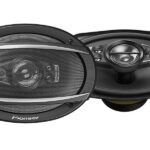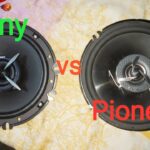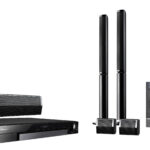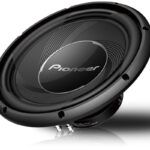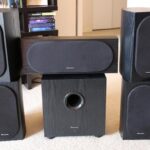Introductions:
If you are looking for a subwoofer to make a better sound experience, you may wonder what the difference is between a JBL subwoofer LFE vs a normal subwoofer. All Subwoofers aren’t the same, and they have different features, performance, and benefits. In this guide, we will explain everything about LFE vs normal Subwoofers, how they work, and how to choose the right one for you.
LFE Subwoofers
What is an LFE subwoofer?
LFE subwoofer is a type of subwoofer that uses a special input channel to receive low-frequency effects from a receiver. It stands for Low-Frequency Effects, a dedicated audio channel that carries bass sounds such as explosions, gunshots, or thunder. The subwoofer can reproduce these sounds more powerfully and clearly than a regular subwoofer.
How do LFE subwoofers work?
It works by receiving a dedicated audio channel from a receiver or a digital theater system with only low-frequency effects.
These effects have a frequency range of 3 to 120 Hz, lower than the full-range audio signal.
The subwoofers use a single RCA cable or an LFE cable to connect to the receiver or the system. They also have a built-in amplifier that boosts the signal and drives the speaker cone.
The speaker cone then vibrates and produces low-frequency sounds that can be felt and heard.
What are the benefits of using an LFE subwoofer?
Some benefits of using an LFE subwoofer are:
- Enjoy more realistic and immersive movies, games, or music sound effects.
- Adjust the volume and crossover frequency of the subwoofer independently from the main speakers, allowing you to fine-tune the bass level to your preference.
- Avoid distortion or interference caused by sending low-frequency signals through speaker wires or other inputs.
Normal Subwoofers
What is a normal subwoofer?
The normal subwoofer is a speaker that produces low-frequency sounds, also known as bass. A subwoofer is usually part of a larger audio system, such as a home theater or a car stereo, which includes other speakers that handle the higher frequencies. A subwoofer can enhance the sound quality and realism of movies, music, games, and other audio sources by adding depth and impact to the low-end sounds.
Normal subwoofers are different from shallow-mount subwoofers, which are designed to fit in tight spaces. Normal subwoofers have a deeper mounting depth, requiring more space to install. They are also generally larger and heavier than shallow-mount subwoofers. However, normal subwoofers can produce more powerful and louder bass than shallow-mount subwoofers, as they have more room to move air.
How do normal subwoofers work?
Normal subwoofers produce low-frequency sounds, also known as bass, that enhance the sound quality and realism of movies, music, games, and other audio sources. And use speaker drivers, or woofers, with a large diameter and a deep mounting depth. These woofers can move more air, creating more powerful and louder bass than smaller or shallower woofers.
Normal subwoofers are connected to an audio receiver or preamplifier that sends low-frequency signals, referred to as low-frequency effects (LFE), to the subwoofer via an electrical current. The subwoofer has a built-in amplifier that boosts the signal and drives the woofer cone. The woofer cone then vibrates and produces low-frequency sounds that can be felt and heard.
What are the benefits of using a normal subwoofer?
Advantages:
- Deliver more realistic and immersive sound effects in movies, games, or music.
- Handle more power and volume without distortion or damage.
- Offer more flexibility and options regarding size, shape, enclosure type, and placement.
Disadvantages:
- It takes up much space and adds weight to the audio system.
- They are more expensive and difficult to install than shallow-mount subwoofers.
- Cause unwanted vibrations or noise in the surrounding environment.
Some examples of normal subwoofers
Polk Audio PSW10: is a 10-inch subwoofer that delivers 50 – 100 watts of dynamic power. Frequency response of 35 – 200 Hz and a variable low-pass filter. It is easy to connect and adjust with any audio system.
Klipsch R-120SW: This is a 12-inch subwoofer that delivers 200 watts of continuous power and 400 watts of dynamic power. It has a frequency response of 29 to 120 Hz and a digital amplifier. It is designed to deliver deep and clean bass with minimal distortion.
SVS PB-1000 is 10-inch & 300 -700 watts of peak power. Response of 19 to 270 Hz and a DSP-based amplifier. It is capable of producing chest-thumping bass with high precision and accuracy.
A normal subwoofer is a great choice for anyone who wants to enjoy powerful and realistic bass in their audio system. However, it is important to consider the user’s space, budget, and preference before buying one. To learn more about normal subwoofers, you can visit these websites that provide more information and reviews on different models and brands.
Here is a comparison table between LFE and Normal Subwoofers:
| Feature | LFE Subwoofers | Normal Subwoofers |
| Definition | LFE stands for Low-Frequency Effects1. It is the “surrounding” effect of the main speakers1. | A normal subwoofer is designed to produce clear, low-pitched audio frequencies2. |
| Purpose | The LFE cables are used to connect your subwoofer (low-frequency speaker) to the receiver it uses3. | A normal subwoofer is designed to produce clear, low-pitched audio frequencies2. |
| Connection | An LFE (low-frequency effects) input cable is typically used to link the subwoofer to the receiver3. | A normal subwoofer can be connected using RCA connections or speaker-level inputs45. |
| Frequency Range | The LFE channel is responsible for bass effects such as explosions and gunshots within the 3 to 120 Hz audio frequency range4. | The typical frequency range for a normal subwoofer is about 20–200 Hz for consumer products, below 100 Hz for professional live sound, and below 80 Hz in THX-certified systems6. |
Choosing the Right Subwoofer for You
Choosing the right subwoofer for you can be a challenging task, as there are many factors to consider and options to choose from
Factors to consider when choosing a subwoofer
- Size and space of your room or vehicle: Measure the dimensions and volume of your space and find a subwoofer that can fit and perform well in it.
- Type and quality: You must match the subwoofer with the rest of your audio system, such as the receiver, amplifier, speakers, and cables. Check your components’ compatibility, impedance, sensitivity, power handling, and frequency response, and find a subwoofer that can work well with them.
- Budget and preference: Set a realistic budget and find a subwoofer to meet your expectations and satisfaction. Compare the features, performance, design, and price of different subwoofers and find the best value for your money.
This is one of the main choices you must make between an LFE and a normal subwoofer. An LFE is a special subwoofer that uses a dedicated audio channel to receive low-frequency effects from a receiver or a digital theater system. These effects include sounds such as explosions, gunshots, or thunder. An LFE subwoofer can reproduce these sounds more powerfully and clearly than a normal subwoofer.
A normal subwoofer is a regular subwoofer that receives the full-range audio signal from a receiver or a preamplifier. It produces low-frequency sounds, including musical notes, voices, and ambient noises. The normal subwoofer can produce a more powerful and louder bass than an LFE, as it can move more air and create more pressure.
How to choose between an LFE and a normal subwoofer
The choice between an LFE and a normal subwoofer depends on the source and content of your audio, the configuration and setup of your audio system, and the size and space of your room or vehicle. An LFE subwoofer is preferred for movies or games with low-frequency effects, while a normal subwoofer is preferred for music or other audio sources with a wider range of low-frequency sounds. The type of receiver or preamplifier you have and the available space also play a role in the decision.
Setting Up Your Subwoofer
The steps are similar for LFE and Normal subwoofers. Place it near a wall or corner for better bass, and connect it to your audio system with a good cable. Plug in the power cord of your subwoofer and turn it on. Adjust the settings, including the crossover frequency, phase control, and volume. Room acoustics also impact sound, so consider curtains, carpets, and furniture. Proper setup ensures great low-frequency audio.
Conclusion :
The choice between an LFE and a normal subwoofer depends on several factors, such as the audio source and content, the audio system’s configuration and setup, and the size and space of your room or vehicle. We hope this article has helped you understand the differences between LFE and normal subwoofers and how to choose the right one for you.
FAQ
What is RCA input in a subwoofer?
RCA input in a subwoofer refers to the left and right inputs (RCA connections) used to send low frequencies through the right and left channels of the speaker system, respectively.
What cable do I need to connect my subwoofer to my receiver?
You will likely use an LFE input cable to connect your subwoofers to your amplifier. Left and right input are significantly less likely to be used today; however, they are still possible.
What is the crossover frequency on a subwoofer?
The crossover frequency on a subwoofer is the frequency at which the subwoofer takes over from the main speakers to reproduce low-frequency sounds. It is usually set between 80-120 Hz.
What is the phase control on a subwoofer?
The phase control on a subwoofer allows you to adjust the timing of the sound waves produced by the subwoofer in relation to the main speakers. This helps to ensure that the sound waves from all speakers arrive at your ears at the same time, resulting in a more cohesive sound.
How do I choose the right subwoofer for my home theater system?
When choosing a subwoofer for your home theater system, consider factors such as the size of your room, the type of content you will be watching, and your personal preferences. It is also important to match the subwoofer with the rest of your speaker system for optimal performance.

